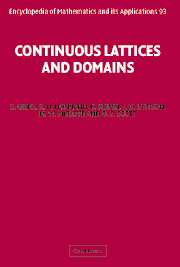Book contents
- Frontmatter
- Contents
- Preface
- Acknowledgments
- Foreword to A Compendium of Continuous Lattices
- Introduction to A Compendium of Continuous Lattices
- O A Primer on Ordered Sets and Lattices
- I Order Theory of Domains
- II The Scott Topology
- III The Lawson Topology
- IV Morphisms and Functors
- V Spectral Theory of Continuous Lattices
- VI Compact Posets and Semilattices
- VII Topological Algebra and Lattice Theory: Applications
- Bibliography
- List of Symbols
- List of Categories
- Index
VII - Topological Algebra and Lattice Theory: Applications
Published online by Cambridge University Press: 13 August 2009
- Frontmatter
- Contents
- Preface
- Acknowledgments
- Foreword to A Compendium of Continuous Lattices
- Introduction to A Compendium of Continuous Lattices
- O A Primer on Ordered Sets and Lattices
- I Order Theory of Domains
- II The Scott Topology
- III The Lawson Topology
- IV Morphisms and Functors
- V Spectral Theory of Continuous Lattices
- VI Compact Posets and Semilattices
- VII Topological Algebra and Lattice Theory: Applications
- Bibliography
- List of Symbols
- List of Categories
- Index
Summary
Our final chapter is devoted to exploring further links between topological algebra and continuous lattice and domain theory. This theme has already played an important role: the Fundamental Theorem of Compact Semilattices (VI-3.4) is just one example. In this chapter, however, the methods of topological algebra occupy a more central role, while the methods of continuous lattices are somewhat less prominent.
Section VII-1 is devoted to somewhat technical results about certain non-Housdorff topological semilattices; they are included primarily to facilitate the proof of later results concerning separate continuity of semilattice and lattice operations implying joint continuity. Section VII-2 makes various observations about topological lattices and their topologies, with a particular focus on completely distributive lattices.
Section VII-3 introduces the class of continuous lattices for which the Lawson topology is equal to the interval topology: the hypercontinuous lattices. The distributive ones are paired with the quasicontinuous domains via the spectral theory of Chapter V. Thus several earlier themes are nicely rounded out.
Section VII-4 characterizes those meet continuous complete lattices which admit a compact semilattice topology as being exactly those lattices whose lattice of Scott open sets forms a continuous lattice; this augments II-1.14, which shows that the continuous lattices are exactly those complete lattices whose Scott open sets form a completely distributive lattice. The final part of Section VII-4 is devoted to a proof that a compact semitopological semilattice is in fact topological.
- Type
- Chapter
- Information
- Continuous Lattices and Domains , pp. 492 - 522Publisher: Cambridge University PressPrint publication year: 2003



